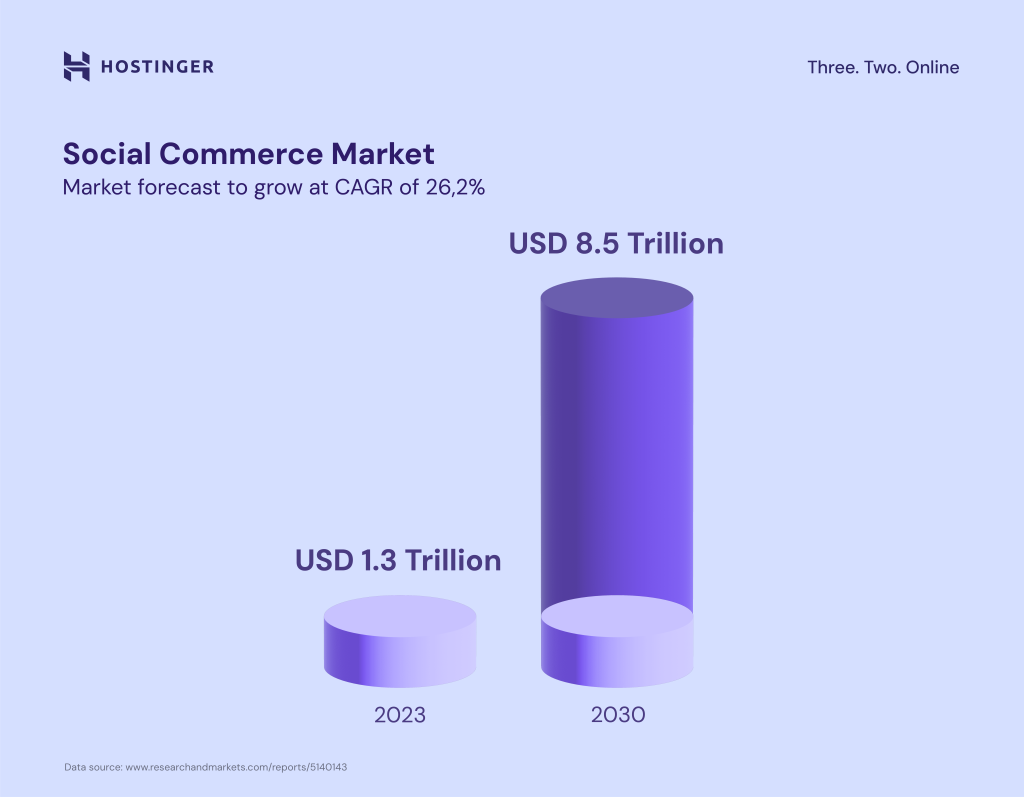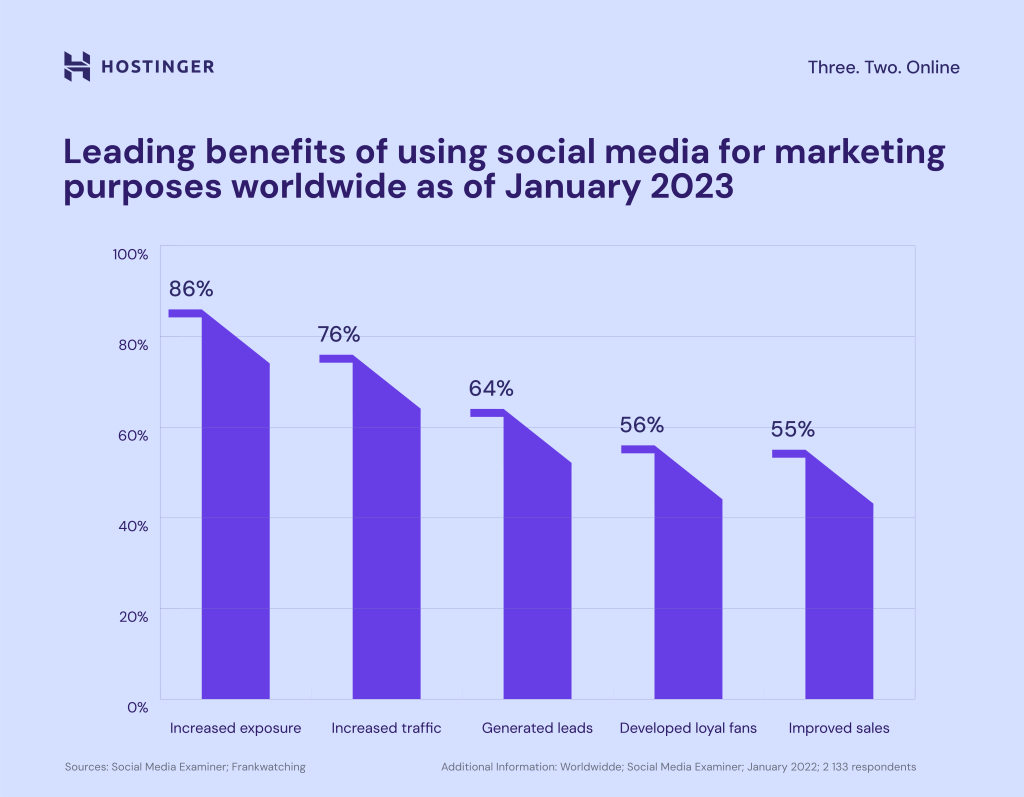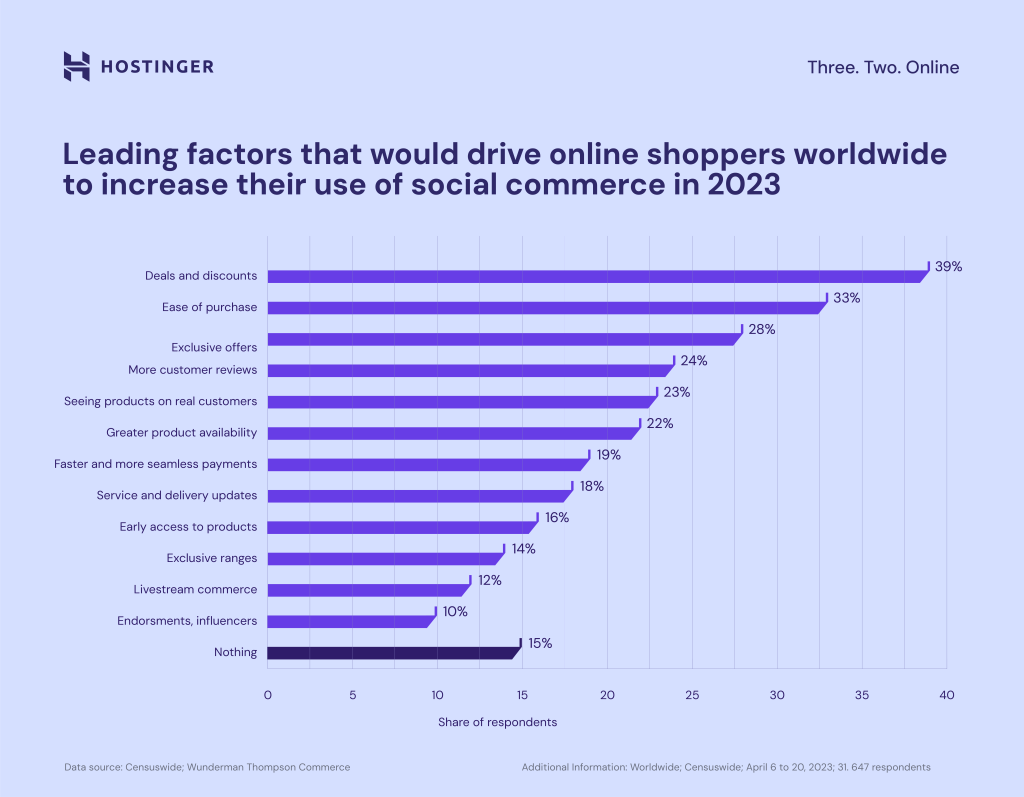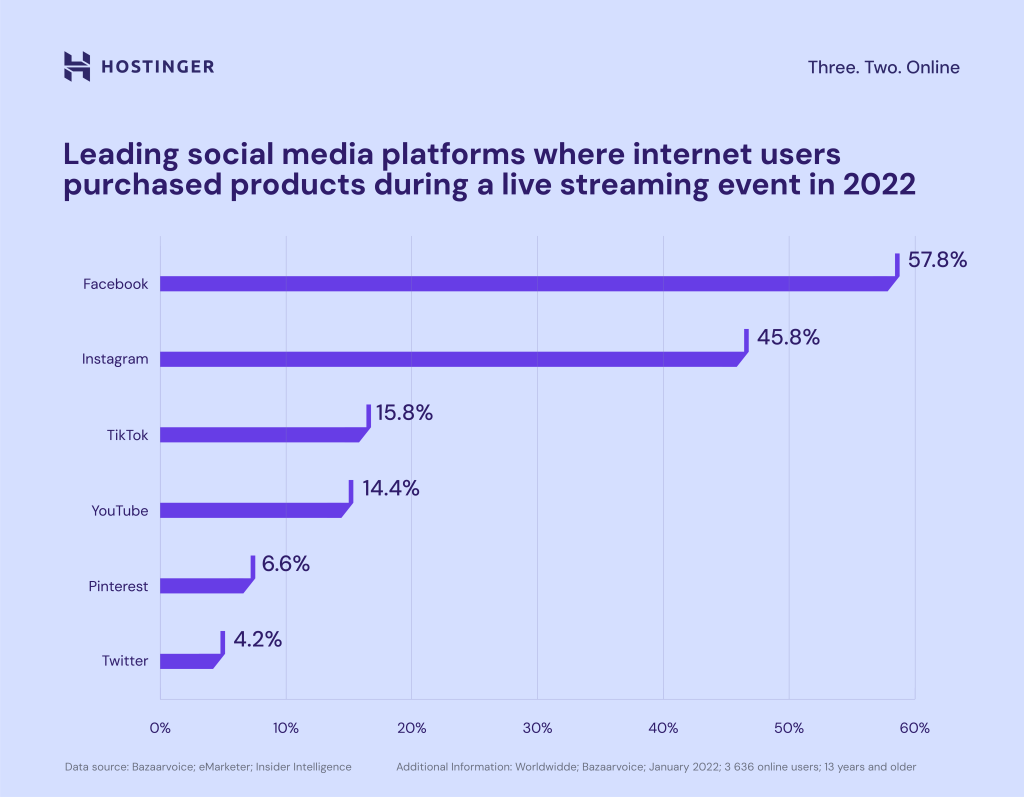Social Commerce 2024: Definition, Key Trends, and Statistics
Social commerce, the convergence of social media and online shopping, has rapidly transformed how consumers discover and purchase products.
According to the latest eCommerce statistics, global eCommerce revenue is expected to surpass $5.5 trillion by 2027. In other words, social commerce is predicted to play a key role in the way we shop online in the future.
In this article, we will examine the definition, key trends, and top statistics of social commerce in 2024. This should give you a comprehensive overview of how to best leverage social media and eCommerce in your digital marketing strategy.
Download checklist: How to start an online business
What Is Social Commerce?
Social commerce is the practice of using social media platforms to promote and facilitate eCommerce transactions. It involves leveraging social networks to help with product discovery, recommendations, and sales, combining social interaction with eCommerce trends and functionalities.
Comparison: Social Commerce vs. eCommerce
Understanding the difference between social commerce and eCommerce helps you learn which one works best for your needs.
Social commerce integrates shopping within social media platforms, allowing users to discover and purchase products directly on these sites. Compared to eCommerce, social commerce emphasizes community engagement and streamlined shopping experiences.
For example, let’s say you see a friend’s pool party pictures on Instagram and love their swimsuit. Social commerce enables you to click a tag on the photo, buy the swimsuit directly on Instagram, and have it delivered to your house – all without leaving the app.
In contrast, eCommerce commonly refers to standalone online stores where transactions occur independently of social media.
The Rise of Social Commerce
Social networks have significantly influenced online shopping, providing businesses with new opportunities to interact with customers. In this section, we will look at the fast growth of social commerce.
1. Social Commerce Penetration Rate Projected to Reach 25% in 2024
Social commerce is set to reach a 25% penetration rate in 2024, meaning one in four potential customers use social media to shop.
In 2023, social commerce generated $571 billion. With an expected annual growth rate of 13.7%, it’s projected to exceed one trillion dollars by 2028. This rapid growth signifies a booming market where businesses can connect with new customers and boost sales.
2. Global Social Commerce Market Forecasted to Reach $8.5 Trillion by 2030
Social commerce is expected to skyrocket, with global sales projected to reach $8.5 trillion by 2030. This immense market size presents a significant opportunity for businesses to expand their reach and tap into a worldwide audience.
In 2023, the market was valued at $1.3 trillion, already reflecting a significant growth trend. This rapid expansion, driven by a 26.2% compound annual growth rate (CAGR) from 2023 to 2030, highlights the increasing popularity of online purchases made through social media platforms.
3. Millennials to Represent 33% of Social Commerce Spending
By 2025, millennials are expected to account for 33% of global social commerce spending, making them the largest demographic in this market.
Millennials are followed closely by Gen Z shoppers, who are projected to account for 29% of the spending. This trend highlights a tech-savvy generation comfortable with in-app purchases, making clear the influence of younger generations in driving social commerce growth.
4. U.S. Social Commerce Expected to Surpass $90 Billion in 2025
As social media’s influence continues to grow, these sales are projected to reach close to $150 billion by 2028.
In 2023, U.S. social commerce sales were nearly $64.8 billion, and the market is expected to exceed $90 billion in sales in 2025.
The U.S. market is a leader in social commerce adoption, offering businesses a fertile ground to implement social selling strategies and reach a highly engaged audience.
5. U.S. Social Media Drives Almost 60% of Purchases
Approximately 58% of shoppers in the United States reported purchasing a product after seeing it on a social media platform.
By comparison, 44% of respondents in the United Kingdom and 40% in Germany said they bought something after spotting it on social networks. This highlights the immense potential for businesses to leverage social media for product promotion and sales.
Social Commerce Platforms Driving Industry Growth
Social media platforms have become powerful tools for driving sales and engagement in the eCommerce space.
This section provides an overview of some of the most popular social commerce platforms, showcasing how they contribute to the industry’s growth.
6. Two-Thirds of Millennials Buy From Social Media
In 2023, roughly two-thirds (65%) of millennials purchased goods from the social media accounts of brands they follow.
In comparison, about 60% of Gen Z users followed and bought from brands, while approximately 52% did so from influencers. Gen X users showed a strong preference for retailers, with 61% following and purchasing directly from their social media accounts.
Meanwhile, only 11% of baby boomers followed and purchased from influencers. The younger generations are well-versed in social commerce, meaning businesses already have a massive and engaged audience to target.
7. Douyin Leads Global Social Commerce Revenue, Nearing $200B in 2024
China’s short-form video platform Douyin is the top global revenue generator in social commerce, with estimated revenue nearing $200 billion in 2024.
WeChat is second with a projected revenue of nearly $152 billion, followed by Little Red Book, which ranks third with $94.2 billion. In contrast, TikTok, the international version of Douyin, is expected to generate over $20 billion.
Meta’s platforms, Facebook and Instagram, are projected to earn $56.8 billion and $37.2 billion, respectively. Douyin’s dominance in the social commerce market is clear, and we can see a significant gap between Chinese platforms and their international counterparts.
However, for businesses targeting a global audience, established platforms like Facebook and Instagram still offer significant reach and revenue potential.
8. About 27% of Global Online Shoppers Prefer Facebook for Purchases
In 2023, 27% of global online shoppers named Facebook as their preferred social network for making purchases. Instagram, also operated by Meta, ranked second, with 20% of respondents choosing it for shopping.
Facebook is not only favored for purchases but also recognized for providing the best social commerce experience worldwide, with 23% of global consumers rating it the highest. Instagram follows closely at 18%, with YouTube and TikTok both at 8%.
As the world’s top social media platform, Facebook boasts over three billion monthly active users. Meta Platforms also owns four of the largest social media platforms, each with over one billion monthly users – Facebook and Messenger, WhatsApp, and Instagram.
This dominance underscores Facebook’s critical role in the social commerce landscape. For businesses of all sizes, having a presence on Meta’s platforms allows them to tap into a massive user base with a proven track record of social commerce success.
9. Instagram Leads as Preferred Shopping Platform for Gen Z and Millennials
In 2023, Instagram was the preferred social media platform for shopping among Gen Z (70%) and millennial (63%) consumers.
Gen Z also favored TikTok for shopping (58%), while millennials leaned towards YouTube (52%) and Facebook (49%).
Older generations showed different preferences, with Gen X (63%) and baby boomers (66%) favoring Facebook and YouTube for their social commerce activities. Understanding these generational preferences allows businesses to tailor their social commerce strategy to reach the right audience on the right platform.
10. TikTok Users Most Prone to Impulse Buying
In 2022, more than half (55%) of TikTok users reported they made impulse purchases on the platform, making them the most susceptible to impulse buying. Instagram users came in second, with 46% engaging in impulse purchasing.
In 2023 alone, TikTok generated $3.8 billion in consumer spending, adding to its cumulative total of over $6 billion since 2016.
This rapid growth highlights TikTok’s influence on shopping behavior. 71.2% of users report beginning to shop when they stumble across items in their feed, and 58% use the platform for shopping inspiration.
For businesses looking to drive impulsive purchases and capitalize on quick trends, TikTok offers a unique opportunity to reach a highly engaged and impulse-driven audience.
11. Unbranded Searches Dominate Pinterest’s Top Searches
In 2023, 96% of the top searches on Pinterest were unbranded, indicating users’ openness to new ideas and product discoveries.
With over 498 million monthly active users worldwide, Pinterest generated $3.1 billion in revenue in 2023.
The dominance of unbranded searches highlights the platform’s unique position as a discovery tool. Users actively seek inspiration rather than specific brands, which provides advertisers with a valuable opportunity to capture attention at the moment of inspiration.
Advantages of Social Commerce
Enriched engagement, direct customer interaction, personalized experiences, and ease of purchase are just a few advantages that make social commerce a vital part of modern eCommerce strategies.
This section explores these benefits in detail, illustrating how they can drive business success.
12. One-Third of Gen Z and Millenials Completely Trust Influencer Product and Brand Recommendations
In 2023, Gen Z and millennials exhibited the highest levels of trust in product and brand recommendations from social media influencers, with one-third of each cohort expressing complete trust in influencer recommendations.
In contrast, over 40% of baby boomers reported no trust at all in influencer recommendations, showing significantly higher skepticism compared to Gen X (22%) and Gen Z (10%).
According to a 2023 survey, one-third of shoppers discovered a new product or brand through social media in the past six months.
For Gen Z, 60% found new products or brands on social media. Compared to the overall consumer base, Gen Z consumers were almost twice as likely to discover and purchase a product through an influencer.
This highlights a powerful opportunity for businesses to leverage influencer marketing and social recommendations to build trust and drive sales, particularly among younger demographics.
13. Reach up to 62.6% of the Global Population
As of April 2024, there were over five billion social media users worldwide, representing 62.6% of the global population.
Northern and Western Europe had the highest social network penetration rates, at 80.2% and 78.2%, respectively.
Social commerce allows businesses to tap into a massive and active user base, significantly expanding their reach and attracting more clients.
14. 86% of Marketers Report Increased Brand Exposure
Increased exposure is the most commonly cited advantage of using social media for marketing purposes among global industry professionals.
In January 2023, 86% of marketers reported increased exposure as the top benefit. Improved traffic (76%), lead generation (64%), developing loyal fans (56%), and improved sales (55%) were also significant advantages.
Social commerce goes beyond traditional marketing by offering businesses the ability to showcase products directly on social media. This leads to a more engaged audience and higher conversion rates.
15. 72% of Consumers Trust Testimonials
Social proof is a powerful tool for building brand trust, with 72% of consumers trusting reviews and testimonials.
Social commerce platforms provide a natural environment for social proof to flourish. By encouraging customer reviews, user-generated content, and influencer endorsements, businesses can leverage the power of social influence to build trust and drive sales.
These strategies can significantly boost consumer confidence and influence purchasing decisions, ultimately strengthening your brand’s reputation.
Strategies for Success in Social Commerce
57% of global internet users found out about new brands and products through social media.
That’s why knowing how to leverage influencers, utilize social media advertising, and encourage user-generated content are essential tactics for social commerce success.
This section delves into these strategies, emphasizing their importance in reaching potential customers and achieving marketing goals.
16. Influencer Market to Be Worth $24 Billion in 2024
The global influencer market has been growing significantly, more than tripling in value since 2019.
According to the latest digital marketing statistics, this industry is estimated to reach a record value of $24 billion in 2024. This growth highlights influencers’ increasing impact and importance in marketing strategies worldwide.
Partnering with the right influencers allows businesses to tap into a trusted network and reach a highly engaged audience, leading to increased brand awareness and sales.
17. Instagram Influencer Marketing Industry Valued at $22.2 Billion by 2025
The popularity of influencer marketing on Instagram is growing rapidly, with the global market expected to increase from $13.8 billion in 2021 to $22.2 billion by 2025.
In 2021, the platform saw nearly four million brand-sponsored influencer posts, emphasizing Instagram influencers’ central role in modern digital marketing strategies.
Focusing influencer marketing efforts on Instagram allows businesses to leverage a platform specifically tailored for visual content and social commerce, maximizing the impact of influencer campaigns.
18. 39% Shoppers Say Deals and Discounts Motivate Them Engage in Social Commerce
In 2023, deals and discounts were the primary factors motivating 39% of online shoppers globally to participate in social commerce.
Ease of purchase (33%) and exclusive offers (28%) were also significant drivers for consumers to shop via social media platforms.
Social commerce provides businesses with a unique opportunity to reach customers who are actively seeking deals and promotions. By offering exclusive discounts and promotions through social platforms, companies can incentivize purchases and increase sales.
19. 21% of Consumers Trust User-Generated Content for Decision-Making
In 2023, 21% of consumers worldwide were influenced by high-quality reviews when making purchasing decisions, making it the most impactful form of user-generated content.
In contrast, only 4% of consumers found shopper videos compelling enough to influence their buying choices.
Encouraging user-generated content, particularly high-quality reviews and testimonials, allows businesses to leverage the power of social proof and build trust with potential customers.
20. Mobile Ads Spending Increasing to $212 Billion by 2028
In 2028, social media advertising spending is forecasted to reach $255.77 billion, with mobile ads alone accounting for $212.68 billion.
This significant growth stresses the increasing importance of social media ads in delivering a personalized user experience and effectively reaching potential customers.
Social media advertising allows businesses to target specific demographics and interests, ensuring their message reaches the most relevant audience. This targeted approach maximizes the effectiveness of marketing campaigns and increases the return on investment (ROI).
Future Outlook of Social Commerce
The future of social commerce looks exciting, with advancements in technology and evolving consumer behavior driving its growth. In this section, we will look at future trends, technological innovations, and potential market expansion, providing insights into what businesses can expect to see in the coming years.
21. Purchases via Chatbots to Reach $142 Billion by 2024
It’s predicted that retail spending via chatbots will reach $142 billion by 2024.
By implementing AI-powered eCommerce tools like chatbots, businesses can provide 24/7 customer support, answer product questions in real time, and personalize product recommendations based on user preferences.
Since this can all be done within social commerce platforms, chatbots are an excellent tool for increasing customer satisfaction and overall sales for brands.
22. Live Commerce to Surpass $256 Billion by 2032
In 2022, Facebook was the leading platform for live commerce shopping, with 57.8% of global internet users making purchases during live-streamed events.
Instagram followed with 45.8%, while TikTok (15.8%) and YouTube (14.4%) weren’t as frequently used for live commerce purchases.
The global live-streaming market is expected to grow significantly, from $38.87 billion in 2022 to $256.56 billion by 2032, driven by advancements in internet infrastructure and increasing consumer demand for video content.
Live commerce allows businesses to showcase products in real time, interact with customers directly, and create a more engaging shopping experience. This interactive format can increase sales and brand loyalty.
23. AI Integrations Are Expected to Drive Nearly 80% of eCommerce Sales by 2025
According to the latest AI statistics, the global AI market is expected to be worth $305.9 billion by the end of 2024 – and the industry’s growth shows no signs of slowing down.
The integration of AI in social commerce is projected to bring in 79.6% of retail eCommerce sales in the US by 2025.
By leveraging AI, businesses can personalize product recommendations, target the right audience with social media ads, and optimize their social commerce strategy for maximum impact.
24. 82% of Consumers Follow Recommendations of Micro-Influencers
82% of consumers are highly likely to follow a recommendation from a micro-influencer.
Micro-influencers, with their engaged and loyal followings, are powerful allies for brands. Partnering with micro-influencers allows businesses to reach a targeted audience with a high level of trust, leading to increased brand awareness and sales.
25. 53% of Users Shop Directly Through Social Media
53% of global users now make purchases directly through social media platforms like Facebook, Instagram, and TikTok.
This seamless integration enhances the customer journey and allows brands to capitalize on the growing trend of social shopping.
Social commerce offers customers a convenient and streamlined shopping experience. By integrating social commerce into their overall eCommerce strategy, businesses can meet customer demand for social shopping and drive sales directly within the social media platform.
Sources Used
The general information and statistical data were obtained from a variety of sources, including the following websites:
- AWS Marketplace
- Buffer
- Code3
- DigitalDelane
- Forbes
- Hearts & Science
- My FBA Prep
- OptinMonster
- Research And Markets
- Scandiweb
- Shopify
- SimplicityDX
- Skeepers
- Statista
- SunDevs
Conclusion
Social commerce seamlessly blends the power of social media with online shopping, creating a captivating and convenient experience for customers.
Today’s market is currently experiencing explosive growth, and millennials are projected to account for a third of global social commerce spending by 2025.
For businesses looking to connect with a global audience, cultivate brand loyalty, and achieve sustainable growth, social commerce could be a viable marketing avenue to explore.
By integrating social commerce into your digital marketing strategy, you can capitalize on the latest social commerce trends and create memorable shopping experiences.
Social Commerce FAQ
Find answers to some of the most common questions about social commerce below.
How Does Social Commerce Differ from eCommerce?
Social commerce integrates buying and selling directly within social media platforms, allowing users to shop without leaving the app. In contrast, eCommerce typically refers to standalone sites where transactions occur independently of social media. If you’re looking to create your own online store, we recommend using an eCommerce website builder to design your site.
How Does Social Commerce Work?
Social commerce leverages social media platforms to facilitate buying and selling. Brands showcase products, engage with customers, and enable in-app purchases. Features like shoppable posts, live shopping, and social ads streamline the buying process, enhancing convenience and engagement.
What Are Some Examples That Define Social Commerce?
Examples of social commerce include Instagram Shopping and Facebook Marketplace. These platforms allow users to discover and purchase products directly through social media posts, stories, and live streams, merging social interaction with seamless shopping.
What Social Commerce Platform Is Most Popular?
Instagram is one of the most popular social commerce platforms, known for its shoppable posts and stories. Its visual-centric nature, extensive reach, and integration with Facebook make it a preferred choice for brands to engage and sell to their audience.
What Makes Social Commerce Powerful?
Social commerce is a powerful branch of eCommerce because it blends social interaction with seamless online shopping experiences. It leverages user-generated content, influencer partnerships, and real-time engagement, creating an interactive and trust-based environment that drives higher conversion rates.





